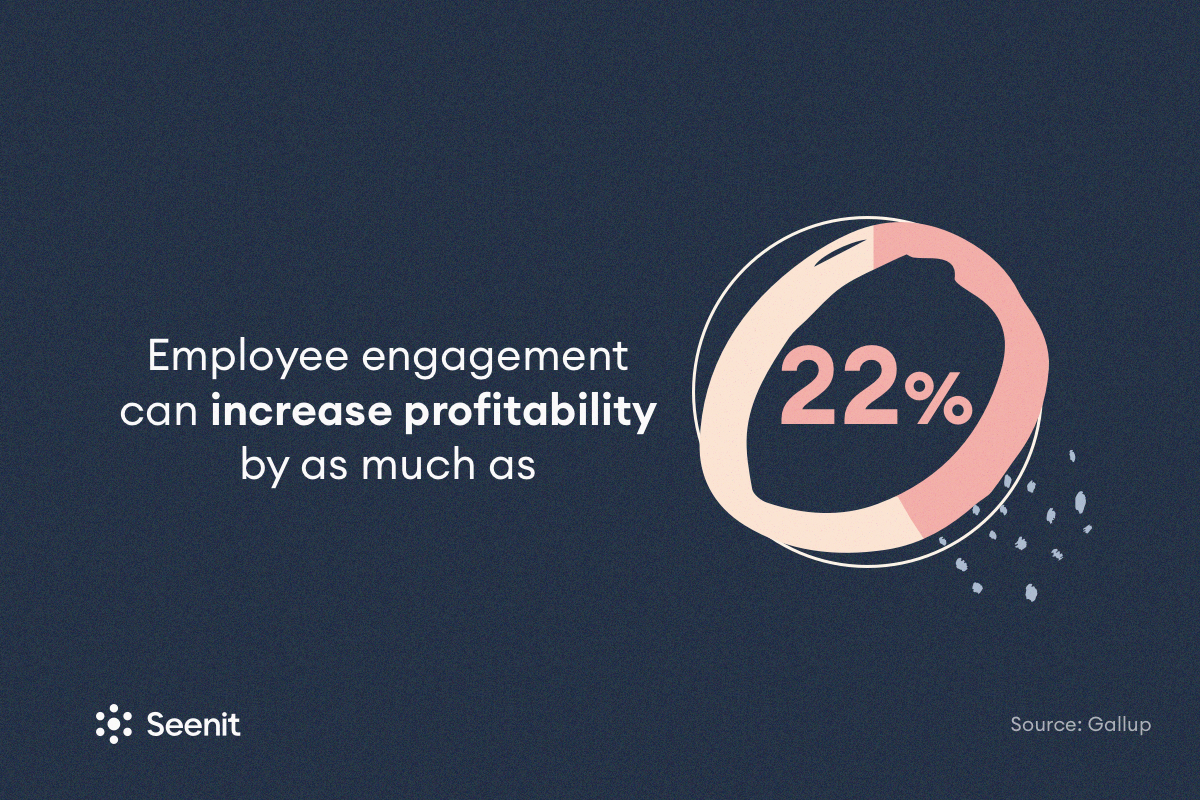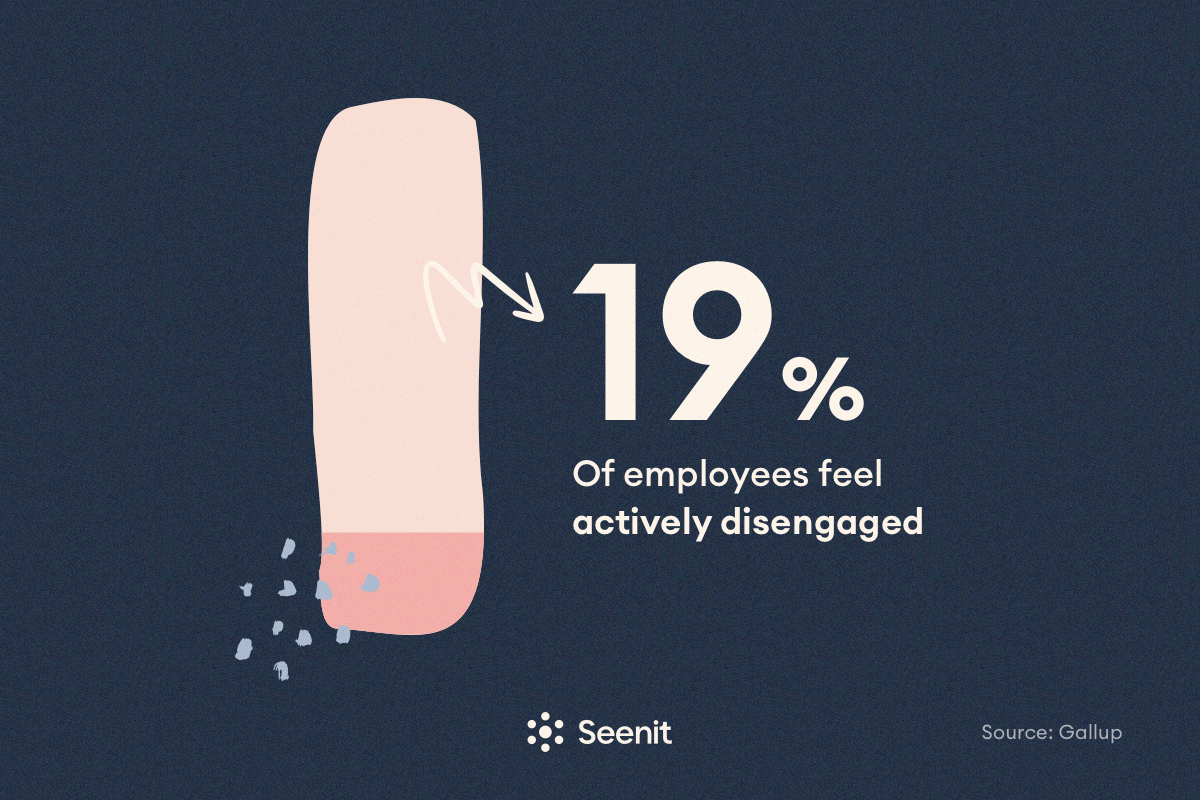Making sure your employees stay engaged isn’t just a nice-to-have, it’s a must for any thriving business. Companies with engaged employees are far more productive and up to 22% more profitable than those with a disengaged workforce.

Engaged workers are essential to your bottom line, but more than that, engaged employees spread positivity, provide better customer service and are more loyal to your company. So it makes business sense in more ways than one, to focus time and attention on engaging your employees.
With 19% of workers feeling actively disengaged, there’s much room for improvement in workplace engagement practices. That’s where a good understanding of the different engagement models can help you understand how engaged your employees are and where there might be improvements you can make.

Let’s take a look at the top 5 engagement models and how they can help you better engage with your workforce.
What is an employee engagement model?
An employee engagement model provides a framework for engaging with your employees to make them feel valued, trusted and happy in the workplace. It underpins your company culture and informs your workplace policies and management behaviours.
Following an employee, engagement model can help you be more strategic in your efforts and avoid implementing isolated initiatives that are likely to be less successful or impactful on their own.
When one of these models is used effectively, it fosters a more positive and caring work environment, improves employee satisfaction and drives greater productivity.
Top 5 employee engagement models to follow
There are several employee engagement models and theories that can be successfully used to engage your workforce. Here’s a rundown of our top five:
Kahn’s employee engagement model
In 1990 William Khan penned his popular employee engagement theory in “Psychological Conditions of Personal Engagement and Disengagement at Work.” In it, Kahn identifies three main factors that affect how much an employee can meaningfully connect with a company’s culture, mission and the day-to-day tasks of their role. These are:
- Safety. Employees are more likely to get involved and feel positive about their role and contribution if they feel psychologically safe in the workplace. This means they don’t fear judgement or punishment from their peers or management.
- Meaningfulness. Workers who find purpose in their work are more likely to work hard for it. In other words, if employees understand how their work contributes towards a meaningful goal, they’re more likely to enjoy their work and make a significant effort.
- Availability. Team members should feel that the demands of their role are reasonable and achievable if they have the mental and physical capacity to succeed in their job. Although this challenge is important for development and job satisfaction, there should also be a healthy work-life balance.
The Kahn employee engagement theory promotes a more holistic approach. It aims to create a more cohesive strategy that tackles all of an employee’s needs, rather than short-term motivational initiatives.
With the Kahn employee engagement model the main focus of improving employee engagement is on:
- Creating a work environment that’s psychologically safe where employees can be themselves and speak openly.
- Seeing employees as partners and teammates rather than taking a hierarchical approach.
- Involving staff, welcoming feedback and allowing them to be part of the process of designing their own roles and meeting company goals.
We’ll deliver our latest content straight to your inbox
Zinger’s employee engagement model
Psychologist David Zinger created his employee engagement model based on the idea that strong and meaningful connections between teammates achieve better business results. The Zinger employee engagement theory is centred around four pillars of employee engagement known as “CARE”: connection, authentic relationships, recognition and (continuous) engagement.
The Zinger model follows a pyramid of ten important engagement actions for managers. Each action is a building block in the pyramid that supports positive employee engagement. In ascending order the pyramid categorises actions as:
- The necessities. This includes actions that:
- Enliven employee energy. These actions focus on fostering a workplace environment that enables staff to bring energy to and gain energy from their work. Well-being and good management play an important role in ensuring energy levels and any drains on team energy are monitored.
- Enhance wellbeing. Good physical and mental health is vital for staff to perform at their best. Actions include building a respect culture, encouraging work-life balance and ensuring ample annual leave.
- Leverage strengths. Employees are unique people with their own individual strengths. Actions in this category focus on creating an environment where team members can draw on and grow their individual strengths.
- Uniting the company involves:
- Building meaningful relationships. Effective teams are built on great relationships. Regular in-person and/or virtual team building and social activities help staff make meaningful work friends.
- Showing recognition. Recognition and rewards, whether a financial bonus, a small gift or thank you video message (see Seenit User-Generated-Videos for inspiration), keep morale and engagement levels high.
- Boosting performance. This category includes:
- Maximising employee performance. Providing staff with clear, appropriate goals and the right tools and processes keeps them performing at their best.
- Tracking progress. Sometimes achieving goals can take a while, so it’s important to continuously track and communicate progress to keep teams motivated and engaged for the long haul. There won’t be a continuous stream of promotions and high-profile wins so it’s essential to recognise the smaller milestones and progress being made too.
- Achieving results. The end goal of your actions is to have effectively engaged your employees. This category is all about tracking and measuring the results of your interventions. This is where it’s important to clearly define your objectives at the start, benchmark data and then decide how you’ll track targets and KPIs. You can then use the results to refine your engagement strategy and better target your engagement efforts.
Maslow’s employee engagement model
Perhaps one of the most famous employee engagement theories, Maslow’s hierarchy of needs, focuses on the human needs that have to be met to create a positive workplace experience. Abraham Maslow first published his theory in 1943 in “A Theory of Human Motivation.”
Maslow’s theory of employee engagement posits that fulfilling each of the five basic human needs – physiological, safety, love and belonging, esteem and self-actualisation – leads to higher employee engagement and motivation.
The Maslow model lists human necessities in a hierarchical pyramid. This sets out that needs in the first level of the pyramid must be met before moving up to the next level. The necessities ascend from basic needs to higher-level needs and are categorised as follows:
- Physiological Needs. At the bottom of the pyramid are basic essentials such as air, water, food, shelter, sleep and clothing.
- Safety needs. This concerns personal security, resources, employment, health and property.
- Love and belonging. These socially focused needs include friendship, intimacy, family and a sense of connection.
- Esteem. This includes self-esteem, respect, status, recognition, freedom and strength.
- Self-actualisation. At the top of the pyramid is the desire to become the best that one can be.
The model theorises that, at the very least, needs on the first level of the pyramid (physiological needs) must be met for employees to feel engaged. This includes earning a comfortable enough salary to provide for basic needs and having enough downtime to sleep and recover. In this model, as needs are met on each level of the pyramid, employee engagement increases and, with it, satisfaction and happiness at work.
AON-Hewitt’s employee engagement model
AON-Hewitt, as a leading consultant on human capital management, has developed its own employee engagement model. This revolves around the idea that business outcomes are a core driver and result of effective employee engagement that impacts customer satisfaction and profit.
The model theorises that there are six main drivers of employee engagement, namely:
- Quality of life basics. This includes safety, job security and a good work-life balance.
- Work. A person feels more engaged when their job aligns with their core beliefs and adds value to their lives. This includes important elements such as collaboration, autonomy and empowerment.
- People. Satisfaction in work centres around meaningful connections with others, including our teammates and managers.
- Company practices. Business policies and practices underpin engagement. This concerns practices around diversity and inclusion, communication and innovation.
- Rewards. How appreciated an employee feels plays a huge role in how valued they feel and how motivated they are. Factors such as rewards, recognition, pay and benefits are all important.
- Opportunities. All of us feel more engaged when we’re challenged and encouraged to grow. Learning and development opportunities, training and promotion all help with staff engagement.
According to AON-Hewitt, if all of these drivers are addressed, you’ll see higher levels of employee engagement that result in:
- Say. Workers speaking positively about your organisation to other potential employees, their peers and customers.
- Stay. Staff feeling proud to work for you and committed to staying for the long haul.
- Strive. Employees who perform well, are happy to go above and beyond and contribute to your company’s success.
In turn, all of this leads to better business outcomes, including greater productivity and financial growth, higher employee retention rates, lower absenteeism and more satisfied customers.
Deloitte’s model
Consulting firm Deloitte has designed an employee engagement model that centres around making work a highly desirable place for employees. Culture is the key to this model’s success and includes five core elements, each with its own set of actions:
- Meaningful work. As with the Kahn and Zinger models, a fundamental of the Deloitte model is to have work that employees find meaningful. This involves four key elements: autonomy, small, empowered teams, time for slack and hiring staff that fit with the company culture.
- Hands-on management. Managers play a critical role in how happy and engaged employees feel at work. Important actions include setting clear, transparent goals, coaching, effectively managing performance and investing in developing management staff.
- Positive work environment. Employees who enjoy coming to work (physically or virtually) are those who feel appreciated, respected, comfortable and part of the team. To foster a good working environment, you’ll need a flexible, inclusive and diverse work environment and a culture of recognition.
- Growth opportunities. Growth and development are important to stop staff from stagnating and becoming disengaged. An effective development strategy should include training, opportunities for promotion and a learning culture.
- Trust in leadership. Engaged employees feel that their leaders are committed to their success. Leadership commitment includes communicating your mission and purpose, transparency, continuous investment in people and inspiring your workforce.
According to Deloitte, following these five core principles and associated actions will create a workplace in which staff are excited to be a part and positively engage.
Build better engagement with Seenit Employee-Generated Videos
Choose an employee engagement model that works for you and your workforce. Make sure to be strategic in your approach and weave your engagement goals and initiatives into your workplace policies and company culture.
By using effective engagement tools like Seenit User-Generated Videos you can make your employee engagement strategy an even greater success. Whether it’s for training, senior management updates, career case studies, an employee-crafted welcome video or sharing a team social, Seenit provides a versatile and more personal approach to employee engagement.
Whether it’s Zinger, Deloitte or another model you opt for, using the right tools and focusing on employee engagement will make for a happier, harder-working workforce and more successful business outcomes.
Get started with Seenit
Transform your talent attraction and employee engagement with Seenit, the AI-enhanced employee-generated content platform






